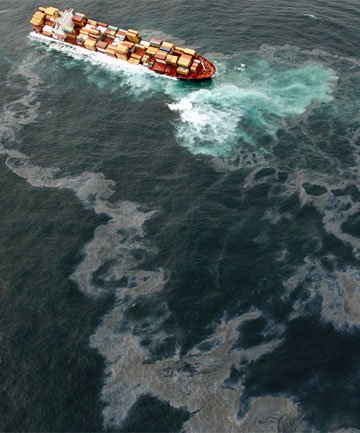The stricken container ship Rena is being hit with four metre swells hampering efforts to remove oil and prevent further major spillages should the ship break up.
 The latest official update from Maritime New Zealand is here.
The latest official update from Maritime New Zealand is here.
The SMC posed questions to international naval architecture experts on the forces at play in the damaged ship and the prospects of it breaking up.
Experts quoted:
David Andrews, Professor of Engineering Design, Department of Mechanical Engineering, University College London.
Neil Bose, Professor of Maritime Hydrodynamics, Director, AMC – National Centre for Maritime Engineering and Hydrodynamics, University of Tasmania.
1. How likely is it that the ship will break up? Could Rena be salvaged in one piece having sustained that type of damage or has it gone past that stage?
Professor Andrews comments:
“With cracking like that appearing, breaking in two at least is looking probable. If the watertight integrity of the aft portion is sufficient then this may float free without capsizing and could then, perhaps be towed to sheltered waters or beached.
“The viability of salvaging in one piece will probably come down to how kind the weather/sea is in the longer term.”
Professor Bose comments:
“When a crack forms on a ship in this way, it is very likely to break up. The pictures shows this crack as very serious and there would be difficulty and danger in salvaging in one piece.”
2. Essentially – what is happening to the ship? What are the forces at play that would create a crack like that in Rena’s hull?
Professor Andrews comments:
“A ship is designed to have its weight supported along its whole length by a smooth distribution of buoyancy. Once a point load support from a rock or a reef or sand bank is introduced then, depending on the severity of the situation, this could induce much higher bending, torsional and shear loads on the hull structure than the ship was designed for, and if this occurs structural failure may follow.
“Furthermore, if a ship’s watertight compartments are breached by a grounding incident then weight-supporting buoyancy from those compartments will be lost and the share of the weight-support that they provided will be transferred to, and will increase, the “ground reactions” at the grounding points, generally making matters worse.
“In principle structural failure could arise in flat calm sea conditions if the ground reactions with fall of tide, etc, were severe enough. However a less compromised vessel that might survive if conditions remained flat calm will be susceptible to progressive structural deterioration if wave actions cause the vessel to flex and move relative to the grounding point(s).
“Any damage that was caused initially by the grounding incident will be exacerbated by the cyclic ‘working’ of the structure: cracks and splits will grow longer and the whole structure will progressively weaken to the point of failure. (This is why in many grounding cases when a vessel cannot be refloated quickly, one of the first things that is done is to ballast the ship down so that it sits more firmly on the sea-bed: this is in an effort to prevent the ship moving/flexing in any waves that hit the area and thereby reduce any progressive deterioration of the structure before refloating can be attempted. This will only be possible, of course, if there is sufficient sea bed profile to sit on in a uniform manner that will adequately support the hull, which doesn’t seem to be the case here.)”
Professor Bose comments:
“The ship is a long beam and the position of the ship on the reef causes more extreme loads in the beam structure than it would normally sustain when floating or docking. These loads cause extreme bending of the beam structure, overloading it and causing cracks to develop, or enlarge and propagate. The structure of the ship will be seriously damaged by being on the reef and the action of the sea.”
3. If the ship breaks up in the continuing bad weather, what is likely to happen to the capped tanks containing the oil within the hull? Would they be likely to stay intact potentially allowing for a recovery of them or the oil to be pumped out?
Professor Andrews comments:
“Hard to say, but the hope would be that they remain intact even if the hull sinks long enough for oil to be removed safely at a later date.”
Professor Bose comments:
“This depends on the position of the tanks. Hence the salvage company is trying to remove the oil.”
4. How do you see this scenario playing out based on past experience? When a ship breaks up what sort of hazards does it create for the marine environment?
Professor Andrews comments:
“See past examples of tanker incidents where the spillage of oil from oil cargo tanks is potentially far greater than the spillage of oil from the bunker tanks of a dry-cargo ship.
“Also look at the story of the ‘Napoli’.”
Professor Bose comments:
“It is a wreck and becomes a hazard in itself. It can discharge contaminants, such as the oil and other debris (containers) into the ocean.”
5. How does this compare to other examples you are familiar with of ships that have gone aground and started to break up? Are there any lessons we can learn from past experience internationally?
Professor Andrews comments:
“As in most cases, to a large extent you are at the mercy of the elements: it depends on whether salvage efforts can proceed faster than the ship weakens.”